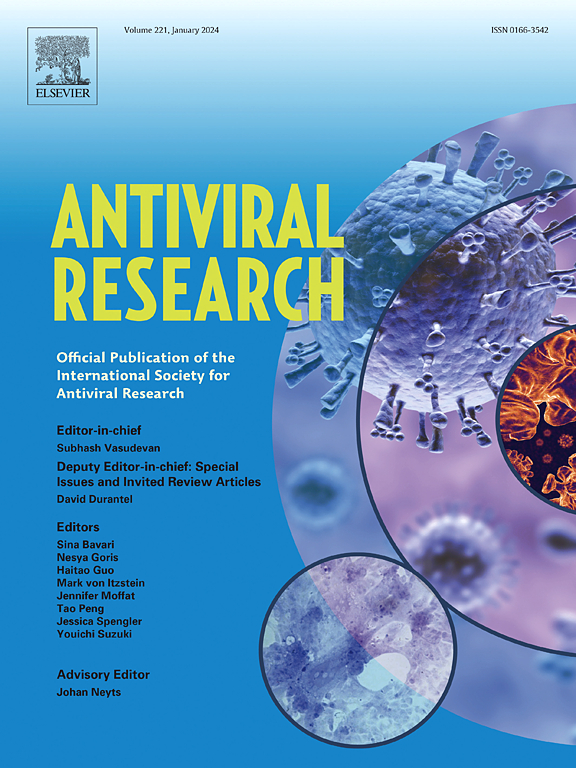贝尼非布韦和鲁扎韦联合使用在体外表现出强大的协同抗病毒活性,同时在体内保持良好的非临床安全性。
IF 4.5
2区 医学
Q1 PHARMACOLOGY & PHARMACY
引用次数: 0
摘要
贝尼非布韦(BEM)是一种鸟苷核苷酸类似物双前药的半硫酸盐,是一种有效的、选择性的、泛基因型的HCV非结构蛋白5B抑制剂,HCV非结构蛋白5B是病毒复制所必需的RNA依赖性RNA聚合酶。同样,ruzasvir (RZR)是一种口服有效、高效、选择性和泛基因型的HCV非结构蛋白5A抑制剂,HCV非结构蛋白5A是病毒复制复合体的重要组成部分。在HCV GT1b Huh-7复制子细胞中测定了这两种互补直接抗病毒药物联合使用的抗病毒效果。两项独立的体外评估表明,BEM和RZR协同作用抑制HCV复制,而不伴有细胞毒性。此外,对BEM和RZR单独或联合给药的毒性和毒性动力学特性进行了研究,大鼠每天口服剂量为500 mg/kg,持续13周,并在第4周进行了中期分析。所有剂量均耐受良好,在单独或联合剂量组中均未发现与试验品相关的不良反应。此外,在给药第1、28和84天进行的毒代动力学分析表明,两种药物在大鼠体内的药代动力学相互作用最小,无论单独给药还是共给药,AT-511 (BEM的游离碱基形式)、其主要循环代谢物和RZR的AUC值都相似。本文章由计算机程序翻译,如有差异,请以英文原文为准。
Bemnifosbuvir and ruzasvir in combination exhibit potent synergistic antiviral activity in vitro while maintaining a favorable nonclinical safety profile in vivo
Bemnifosbuvir (BEM), the orally available hemisulfate salt of the double prodrug of a guanosine nucleotide analog, is a potent, selective, and pan-genotypic inhibitor of HCV nonstructural protein 5B, an RNA-dependent RNA polymerase necessary for viral replication. Similarly, ruzasvir (RZR) is an orally available, highly potent, selective, and pan-genotypic inhibitor of HCV nonstructural protein 5A, an essential component of the viral replication complex. The antiviral effects of the combination of these two complementary direct-acting antivirals were determined in HCV GT1b Huh-7 replicon cells. Two independent in vitro evaluations suggested that BEM and RZR act synergistically to inhibit HCV replication without accompanying cytotoxicity. Additionally, the toxicity and toxicokinetic properties of BEM and RZR administered individually or in combination were investigated in rats given daily oral doses at 500 mg/kg of each drug for 13 weeks, with an interim analysis at 4 weeks. All doses were well tolerated with no test article-related adverse effects identified in either the separate or combined dose groups. Moreover, toxicokinetic analyses conducted on dose days 1, 28 and 84 indicated minimal pharmacokinetic interactions between the two drugs in rats, with AUC values for AT-511 (free base form of BEM), its major circulating metabolites, and RZR being similar, regardless of separate or co-administration.
求助全文
通过发布文献求助,成功后即可免费获取论文全文。
去求助
来源期刊

Antiviral research
医学-病毒学
CiteScore
17.10
自引率
3.90%
发文量
157
审稿时长
34 days
期刊介绍:
Antiviral Research is a journal that focuses on various aspects of controlling viral infections in both humans and animals. It is a platform for publishing research reports, short communications, review articles, and commentaries. The journal covers a wide range of topics including antiviral drugs, antibodies, and host-response modifiers. These topics encompass their synthesis, in vitro and in vivo testing, as well as mechanisms of action. Additionally, the journal also publishes studies on the development of new or improved vaccines against viral infections in humans. It delves into assessing the safety of drugs and vaccines, tracking the evolution of drug or vaccine-resistant viruses, and developing effective countermeasures. Another area of interest includes the identification and validation of new drug targets. The journal further explores laboratory animal models of viral diseases, investigates the pathogenesis of viral diseases, and examines the mechanisms by which viruses avoid host immune responses.
 求助内容:
求助内容: 应助结果提醒方式:
应助结果提醒方式:


